Yesterday’s live coverage of the Ukraine conflict can be found here. An archive of our liveblogs can be found here. For an overview and analysis of this developing story see our latest podcast.
Please help The Interpreter to continue providing this valuable information service by making a donation towards our costs.
For links to individual updates click on the timestamps.
For the latest summary of evidence surrounding the shooting down of flight MH17 see our separate article: Evidence Review: Who Shot Down MH17?
French President François Hollande has met Ukrainian President Petro Poroshenko and has said that the delivery of Mistral Warships which Russia has purchased, for the moment at least, “in the context we all know, isn’t possible.” The Wall Street Journal reports:
“We’re perfectly clear with President Putin. Among the different hypotheses, you’d have reimbursement or payment,” Mr. Hollande said after meeting with Ukrainian President Petro Poroshenko on Wednesday.
Issuing Russia a refund may be the best outcome Poroshenko could expect, since the warships were purchased in 2010, long before this conflict began, and Russia has already paid France €1.2 billion ($1.29 billion). The refund will put closure to the issue and will likely give Ukraine and other Russian neighbors some peace of mind that these ships won’t be helping Russia launch its next attack.
It’s still not clear whether France will be able to find a buyer for the warships if Russia receives a refund.
— James Miller
Novosti Donbassa reports that the ATO press centre has claimed that Russian-backed fighters have attacked Ukrainian positions 32 times between midnight and 18:00 today.
This marks a dramatic increase in the number of attacks, suggesting that the calm we saw at the start of week is well and truly over.
According to the press centre, Ukrainian forces near Mayorsk, north-east of Gorlovka, were shelled twice with 120 mm mortars. In Leninskoye, to the north-west of Gorlovka, Ukrainian troops were attacked, the centre claimed, by a tank.
In Peski, which has been the scene of intense fighting since the battle for Donetsk airport began, Russian-backed forces reportedly attacked Ukrainian positions with 120 mm mortars, 122 mm artillery, automatic grenade launchers, small arms and snipers.
To the north-east of Peski, there were attacks on Ukrainian positions near Novogrodovka and Avdeyevka, the former attacked with artillery, the latter with anti-aircraft guns.
According to the military, Russian-backed fighters attacked Ukrainian troops in Shirokino, east of Mariupol, with 120 mm mortars, anti-aircraft artillery, automatic grenade launchers and small arms.
In the Lugansk region, the press centre reports, the majority of “armed provocations” occurred near the town of Schastye. Russian-backed fighters fired on Ukrainian positions with mortars, anti-tank missiles, automatic grenade launchers and small arms.
In addition, the report claims that four drone flights were detected near Mariupol.
Meanwhile, the pro-separatist Donetsk News Agency (DAN) reports that the ‘ministry of defence’ of the self-proclaimed Donetsk People’s Republic (DNR) has claimed, in an exact mirroring of the statements from the Ukrainian military, that Ukrainian forces have violated the ceasefire 32 times today.
The report gives the exact same list of weapons used in the attacks,
Neither side has reported any casualties so far.
— Pierre Vaux
Andriy Lysenko, spokesman for the ATO, claimed today that a Russian military helicopter had conducted a reconnaissance operation across the Ukrainian border.
Ukrainska Pravda reports that Lysenko said that Ukrainian border guards had discovered a Russian Mi-8 helicopter flying over the border between the occupied region of Crimea and Ukrainian-held territory.
Lysenko also said that the State Border Guard Service had detected 17 Russian drone flights over the Donbass on Tuesday, April 21.
— Pierre Vaux
The following video, uploaded today, shows a convoy of flatbed trucks carrying tanks, purportedly in the Russian town of Kamensk-Shakhtinsky, near the border with Ukraine.
Judging from the side panels on the tanks, which are arranged in a staggered group of three, these could either be T-90s or some upgraded T-72 variant.
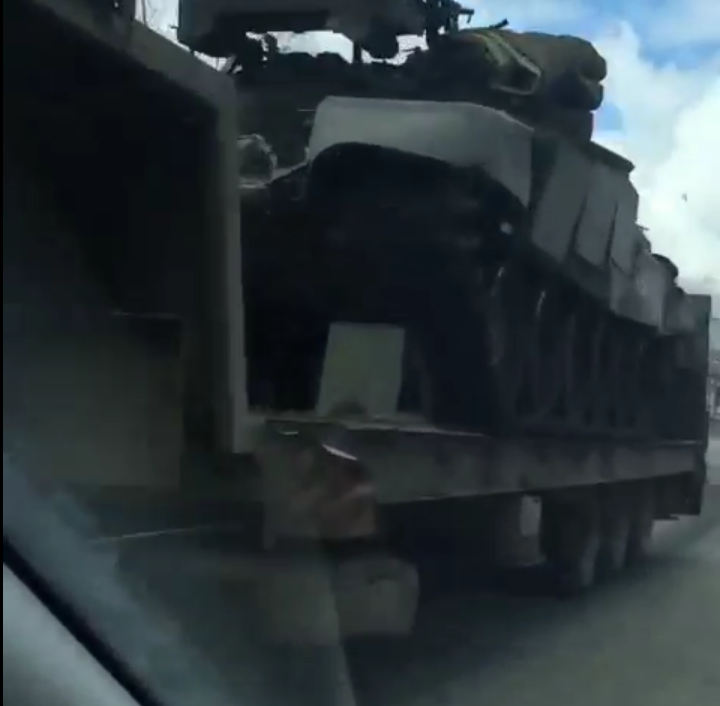
We can pinpoint the location of the convoy by comparing the video to Google Streetview images of Profilnaya street in Kamensk-Shakhtinsky.
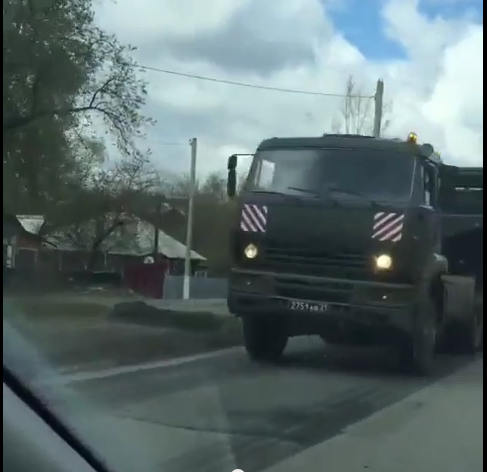
Compare the house and fence visible on the left side of the screenshot above with the one below. Note that the Google Streetview photo dates from 2012 so the telegraph poles may have been erected since then.
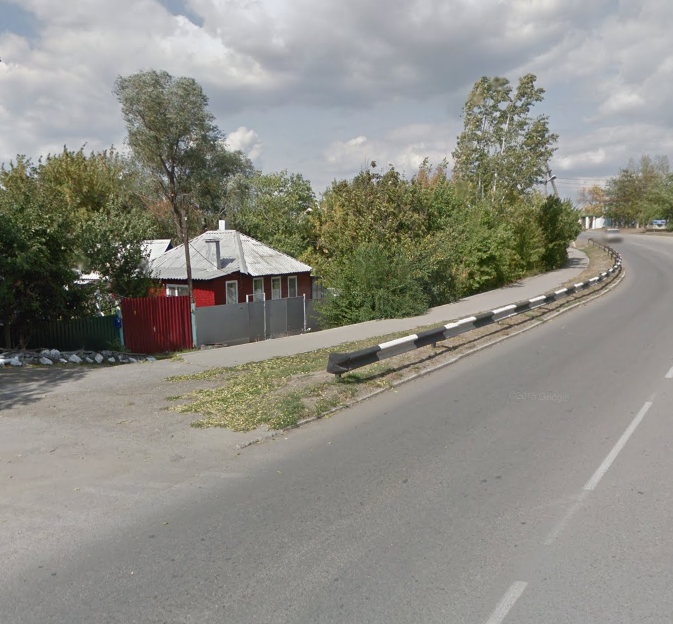
Now compare these screenshots:
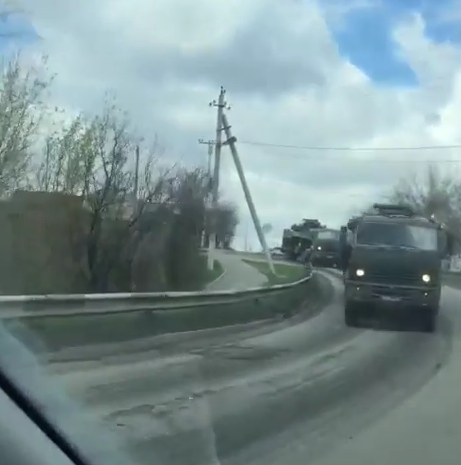
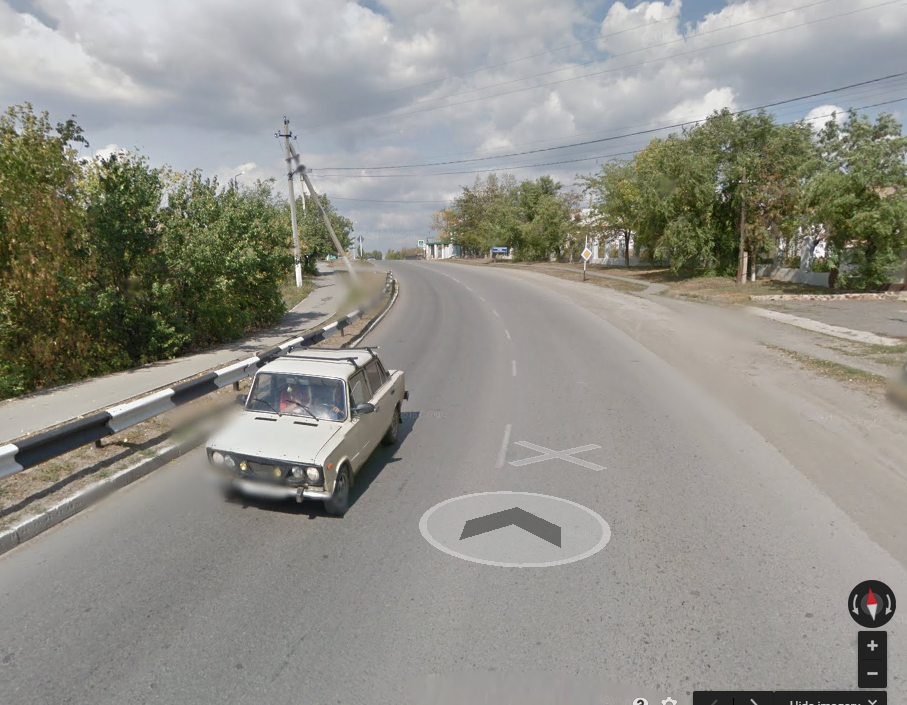
And finally the two highlighted structures in the following screenshots:
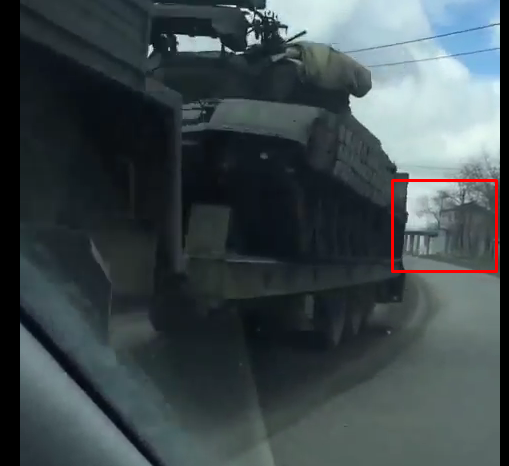
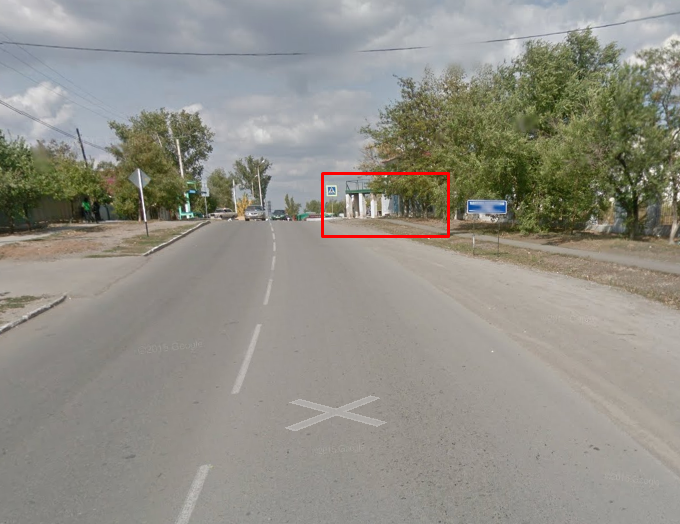
As such, we can determine that the convoy is headed south, and looks likely to join the E40 road, from which it can either head west, along the M21 towards the Russian town of Donetsk, and the Donesk-Izvarino border crossing into Ukraine, or east to join the M4 highway, from which it likely came in the first place (at the northern junction into Kamensk-Shakhtinsky).
Such a manoeuvre would seem aimless so it seems likely to us that these tanks are indeed bound, if not for Ukraine itself, then to wait at the border.
— Pierre Vaux
Still, several things pop out at us. The aircraft formations are a bit unusual — typically, we’re not used to seeing jets fly in a line like that. Also, it’s unusual for jets to fly that close to helicopters. The jets also do not appear to be carrying any armament — missiles, bombs, or even fuel pods — mounted to the underside of their wings.
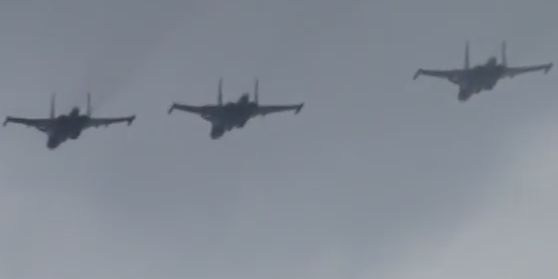
Our best guess — these aircraft may be training for fly-by formations, likely for the May 9th celebration of Victory Day, marking the defeat of the Nazis during World War II. If this flew over your home, especially given recent context with the war in Ukraine, it would certainly be alarming, but it’s not clear whether this equipment is headed toward Ukraine. That, and the fact that this video was uploaded yesterday, indicates that while this may be a show of force, it’s also likely a false alarm.
— James Miller
Easily forgotten amid the focus on Ukraine’s battlefields is the fact that the Euromaidan revolution which toppled the Yanukovych administration and started this current crisis had little or nothing to do with Russia. The protesters in Maidan Square, and elsewhere in cities across Ukraine, saw the Yanukovych government as fundamentally corrupt and the economy as completely dysfunctional. These problems would be hard to tackle if there were no war, but Ukraine has had to cut its costs while increasing defense spending, and much of its energy and political capital has been spent combating the Russian military and its proxies in the east.
In short, the Euromaidan movement may have gotten rid of a dictator, but most in Ukraine understand that the real problems will take much longer to fix.
One reason for that — corruption is built into the power structure of government — at all levels — and of business. When The Interpreter spoke to Ukraine’s foremost anti-corruption campaigner, Aleksei Shalaisky, in September 2014, he described how difficult it would be to remove corruption from the system. Michael Weiss described the interview in Foreign Policy:
“Ukrainian corruption has decreased a bit, but not by much,” Aleksei Shalaisky, the country’s leading anti-graft campaigner and the founder of the website Nashi Groshi (“Our Money”), told me. “The problem is that stealing money is inbuilt into the law, unlike in Russia, where it’s technically illegal but still tolerated. And you cannot change the law until you get rid of all the old people who made it.” But where’s the incentive to criminalize get-rich-quick schemes for freshmen parliamentarians or newly minted government ministers?
“Corruption in Ukraine is very intellectual,” Shalaisky said with a smile. “Sometimes we come up with such interesting schemes that it makes me proud of my nation.”
Shalaisky’s view of the problem were echoed by many at all levels of Ukraine’s government, including Dmitry Shymkiv, who was named as the Ukrainian President’s deputy head for administrative, social, and economic reform last summer. Still, the worry is that Ukraine’s problems will mount before they can be properly addressed.
And there are still significant divisions within Ukraine’s society, exacerbated by the war in the east and tensions with Russia.
Ukraine’s problems are reflected in today’s media coverage. As the fighting in the east remains too low-scale to attract much attention beyond Ukraine’s borders, more attention is being paid to Ukraine’s other persistent problems.
Christian Science Monitor’s Fred Weir writes that “in non-rebel eastern Ukraine, frustrations with Kiev mount.” Weir profiles Kharkiv, while focusing on former members of Yanukovych’s government and the new party which sprang forth from it. While Yanukovych’s allies are of course frustrated, the story does highlight some data which may suggest underlying tensions between the parts of eastern Ukraine which are not embattled and Kiev:
People here overwhelmingly voted for Mr. Yanukovych in 2010. When he was overthrown, separatists started raising their banners and occupying buildings even before unrest broke out in Donbass, where the rebel oblasts of Donetsk and Luhansk lie. But the city’s popularly elected mayor, Gennady Kernes, after briefly flirting with separatism, started strongly advocating reconciliation with the new government, and passions calmed.
Still, when parliamentary elections were held last October, barely 45 percent of people here turned out to vote – remarkably, nowhere in the entire Russian-speaking east and south of Ukraine did voter turnout reach 50 percent. And those who did mostly backed the newly recreated version of Yanukovych’s party, now known as the Opposition Bloc.
In a still unsolved assassination attempt, Mr. Kernes was shot while jogging in Kharkiv a year ago. He spent several weeks recuperating in Israel but, now in a wheelchair, he is back at the city’s helm and more than ever at loggerheads with the Kiev authorities. Later this month he faces trial on charges of abduction brought by the Kiev prosecutor. His supporters insist the charges are without foundation and were trumped up to punish the mayor for his independent stance.
RFE/RL writes that there are signs that many of Ukraine’s best-known politicians, even now, may be corrupt. For instance, Yulia Tymoshenko had very little income in 2014 but was able to buy a new luxury car:
The gaps between officials’ incomes and their assets are a painful reminder of the deep-rooted corruption and insider deals that continue to plague Ukrainian politics, despite being the main cause of two revolutions.
Tymoshenko declared that last year her family purchased a Mercedes Benz GL-350, worth about $78,000, in Ukraine.
“My husband had a business outside of Ukraine, and when repressions started, he sold the business and part of the money he directed to buy the car,” she said.
Tymoshenko’s husband sought political asylum in the Czech Republic after former President Viktor Yanukovych stepped up pressure against his political opponents soon after coming to power in 2010.
Oleksandr Tymoshenko has had a business in that country for many years, but the family income for last year is declared as zero. Yulia Tymoshenko’s personal earnings cover about one-third of the cost of her new car.
The story also discusses similar patterns in the finances of multiple Ukrainian politicians including Oleh Lyashko, Serhiy Lyovochkin, and Ihor Yeremeev, though the article did not definitively prove corruption in any of these cases.
Financial Times’ Tony Barber writes how Ukraine’s conflict has attracted foreign fighters, and highlights a study by Kacper Rekawek of the Polish Institute of International Affairs, a paper which The Interpreter’s editor James Miller was interviewed for.
Maxim Tucker writes for Newsweek that millions of Ukrainian children may be at risk for epidemics as social conditions have degraded due to the war and economic instability, and as vaccinations in parts of Ukraine have, according to the UN, dropped to “zero coverage” in parts of the country.
Still, it’s easy to blame these problems on the current Ukrainian government which is ultimately responsible for fixing them. It’s harder, however, to point out how a fledgling government, already deep in debt, is to fix these issues while its economy is in shambles and it is still fighting a war against the region’s only superpower in the Donbass.
— James Miller
Russia’s state-owned TASS news agency reports that the foreign minister, Sergei Lavrov, has said that Nadezhda Savchenko, a Ukrainian military officer (and now MP) who was captured by separatist fighters and illegally transported to Russia, could possibly be released under amnesty, but only after her trial has taken place.
Savchenko is charged with the murder of two Russian journalists who were killed during a mortar attack on a separatist checkpoint in the Lugansk region. Her lawyers claim that both mobile phone records and a time stamp on a video of her interrogation, uploaded by her captors, prove that she was captured before the attack took place. Furthermore, her illegal rendition to Russia and status as a member of the Parliamentary Association of the Council of Europe mean that her detention and trial are illegal.
Lavrov said, during a live broadcast on several Russian radio stations, that her amnesty was possible under the terms of the Minsk agreement.
The Interpreter translates:
“On the ‘all-for-all’ exchange – she is not a hostage, she was arrested on suspicion of crimes. Here there may be a discussion involving the other parts of the Minsk agreements, which discuss the amnesty of all participants in the events in the south-east. But for someone to be amnestied, they must first be brought to trial, and the court must make the decision.
“If the court decides that she is guilty then it is likely that she can be subject to the amnesty, if I can now interpret the Minsk agreements thus.”
Gazeta.ru notes that Mikhail Fedotov, head of the Presidential Council on Civil Society and Human Rights, said in February that Savchenko desired neither an amnesty nor a pardon, as she does not want to be considered guilty of a crime she did not commit.
— Pierre Vaux
Interfax-Ukraine reports that Andriy Lysenko, spokesman for the Ukrainian military’s Anti-Terrorism Operation (ATO), has told reporters at a briefing today that Russian-backed forces attacked Ukrainian positions with 120 mm mortars 8 times over the last 24 hours.
Under the Minsk agreements, such heavy artillery was supposed to have been withdrawn beyond range of the front lines.
Lysenko said that heavy fighting continued in Shirokino, reflecting reports yesterday from the Azov regiment. According to the spokesman, Russian-backed fighters used tanks as well as small arms in their attacks on Ukrainian positions.
Last night, the Azov regiment claimed that Russian-backed forces had shelled homes in Shirokino.
The Interpreter translated the Ukrainska Pravda report:
“At 18:40, as soon as the OSCE mission had left the village of Shirokino, the terrorists opened fire with mortars on the Azov regiment’s positions. The terrorists’ shells are, for the most part, falling on homes,” said Azov.
“There are reports from the front lines of the Azov regiment in Shirokino that the terrorists are bringing in tanks from the village of Sakhanka,” says the statement.
The ATO press centre claimed today that Russian-backed fighters had conducted more than 20 attacks between 18:00 and midnight yesterday, with numerous attacks north of Donetsk.
According to the report, Ukrainian positions near Peski, Avdeyevka, Novgorodskoye were attacked with 120 mm mortars while positions near the villages of Opytnoye and Pershe Travnya were attacked with anti-aircraft guns and self-propelled artillery.
In the Lugansk region, the press centre claimed, there was an automatic grenade launcher attack on Ukrainian positions near Schastye and a small arms attack near Zolotoye.
The press office of the governor of the region, Hennadiy Moskal, reported further on the events of last night.
The press service said that the last attack was registered at 05:45 on Wednesday.
The day before, clashes occurred near Schastia, Luhansk region, where fortified Ukrainian military positions were attacked by militants using large-caliber machine-guns. The attack originated from Vesela Hora, which is occupied by the militants, the press service said.
Also, a skirmish occurred on the Bakhmutka road, as well near the 29th checkpoint in Stanytsia Luhanska.
“No civilians were injured, no data on wounded or killed servicemen [has been received] yet. The rest of the flash points are tranquil,” the report said.
There were no reported Ukrainian military casualties over the last 24 hours:
Today, there was an unverified report of shooting heard in the city of Lysychansk, on the southern banks of the Seversky Donets river, to the north-west of Zolotoye:
Translation: #Lysychansk 13:26 Unexplained shooting has begun.
— Pierre Vaux